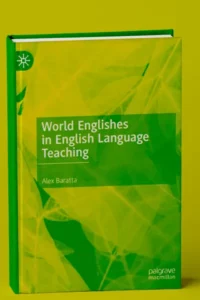World Englishes in English Language Teaching provides an in-depth exploration of World Englishes and their place in the English as a Foreign Language (EFL) classroom.
World Englishes in English Language Teaching
The World Englishes in English Language Teaching book provides an in-depth exploration of World Englishes and their place in the English as a Foreign Language (EFL) classroom. It opens with a critical assessment of the research to date that includes analysis of competing and complementary terms such as English as an International Language (EIL), Global English, English as a Lingua Franca (ELF) and ‘Glocal English’.
Here, and throughout the work, the author problematizes the terminologies used to define and describe Englishes, arguing for example for the need to distinguish between Chinglish and China English. The book then turns to an examination of three case study varieties of non-inner circle English: Konglish, Singlish and Indian English; before exploring the results of an original empirical study into language attitudes concerning several varieties of English among language teachers and learners. Finally, sample exercises for the classroom are provided. This book will be of particular interest to language teachers and teacher trainers, and to students and scholars of EFL and applied linguistics more broadly.
World Englishes in English Language Teaching Book
Presenting thought-provoking discussions, this work problematizes the term native speaker, distinguishes between errors and innovations in World Englishes and provides an argument for a robust codification of non-inner circle Englishes. Included is an attitudinal study of EFL teachers and students from different circles of English in three countries and classroom ideas for integrating non-inner circle Englishes with the more commonly taught varieties of English. This book clearly makes valuable contributions to the fields of World Englishes and English Language Teaching.
This book provides an in-depth exploration of World Englishes and their place in the English as a Foreign Language (EFL) classroom. It opens with a critical assessment of the research to date that includes analysis of competing and complementary terms such as English as an International Language (EIL), Global English, English as a Lingua Franca (ELF) and IGlocal English’.
Here, and throughout the work, the author problematizes the terminologies used to define and describe Englishes, arguing for example for the need to distinguish between Chinglish and China English.
The book then turns to an examination of three case study varieties of non-inner circle English: Konglish, Singlish and Indian English; before exploring the results of an original empirical study into language attitudes concerning several varieties of English among language teachers and learners.
Finally, sample exercises for the classroom are provided. This book will be of particular interest to language teachers and teacher trainers, and to students and scholars of EFL and applied linguistics more broadly.


